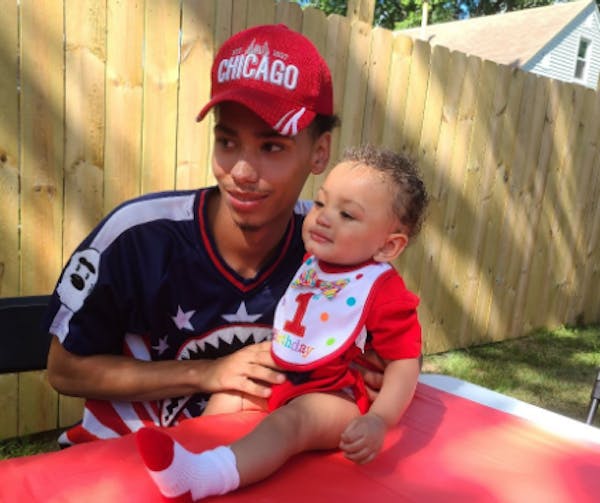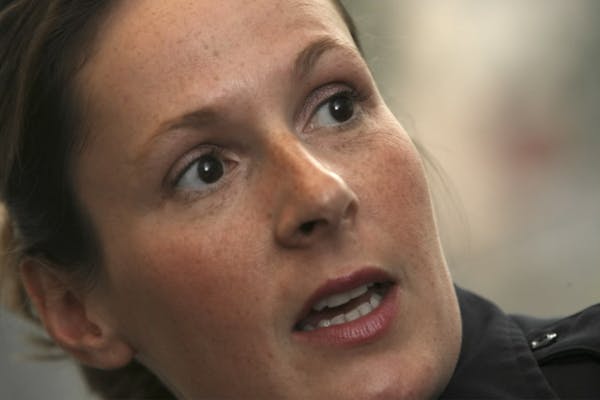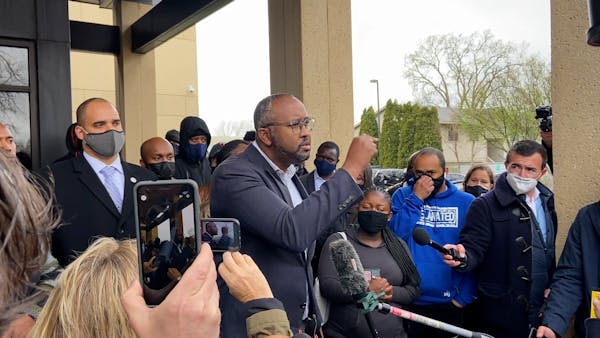The traffic stop that would end Daunte Wright's life played out on a Brooklyn Center police officer's body camera. Officers appeared to try to handcuff him; then he slipped back into the driver's seat.
A female officer yelled, "Taser, Taser," and then fired her gun. "Holy shit, I just shot him," she said.
Once again, a Black man died during a police encounter. In an instant, the world's focus on Minnesota shifted from the trial of Derek Chauvin to a new outrage that brought street protests, promises of reform, and anguish over a relentless pattern of deadly police misconduct.
Military vehicles rumbled down city streets as businesses hastily closed to comply with a four-county 7 p.m. curfew Monday ordered by Gov. Tim Walz. While a massive police presence mobilized to prevent any repeat of the riots after the death of George Floyd, President Joe Biden called for "peace and calm."
At a 12:30 a.m. Tuesday news conference, Minnesota State Patrol Col. Matt Langer said that 40 people were arrested Monday night at the Brooklyn Center protest. Several law enforcement officers suffered minor injuries from thrown debris; no protester injuries were reported, he said.
In Minneapolis, 13 people were arrested, according to Minneapolis Deputy Police Chief Amelia Huffman.
Heeding the demands of protesters, Brooklyn Center's leaders dismissed the longtime city manager and granted authority over police to Mayor Mike Elliott. Elliott will make a decision Tuesday about whether to fire police Chief Tim Gannon, who described the officer's use of a firearm instead of a Taser as an "accidental discharge."
The Minnesota Bureau of Criminal Apprehension identified the officer as Kimberly A. Potter, 48, who has been a police officer for 26 years. She has been put on leave.
Washington County Attorney Pete Orput promised a "thorough yet expedited" review of the case with the hope that the office can have criminal charges drafted Tuesday or Wednesday.
The shooting happened about 2 p.m. Sunday in the area of N. 63rd and Orchard avenues. Gannon said he was told during a briefing that officers stopped Wright's car because it had an expired tag and, when they checked his name, found he had a warrant.
According to Hennepin County District Court records, a warrant was issued April 2 for Wright after he failed to make his first court appearance on a case filed in March of carrying a pistol without a permit, a gross misdemeanor, and fleeing police, a misdemeanor. It's unclear whether Wright knew he had a court hearing, as he was charged by summons.
The body camera footage shows three officers approaching a white sedan parked on the shoulder of a road. One officer approaches the driver's side window, while another approaches the passenger side. The officer on the driver's side opens the door and Wright gets out of the car. Wright's hands are then shown behind his back, and an officer pulls out handcuffs.
Someone says, "You have a warrant."
A third officer, identified as Potter, moves closer to the car and places a hand on Wright's arm. Wright evades her grasp. The video briefly shows officers moving near the car door, as Wright moves into the driver's seat. Then he's shot.
Off-screen from the video, police said the car crashed into another vehicle near Kathrene Drive. Wright died there. The Hennepin County Medical Examiner's Office said Wright died of a gunshot wound to the chest and labeled his death a homicide.
"I'm not in the mind of the officer," Gannon said during the news conference. "I can only see what you're seeing. I can couple that with much of the training that I have received, and that's why I'm believing it to be an accidental discharge."
The BCA is leading the investigation into Wright's death, as is typical for shootings involving officers. Local prosecutors made an arrangement roughly a year ago to take over such cases for each other, so they can avoid the appearance of a conflict of interest.
Orput said late Monday afternoon that he had not received the BCA's investigative report but that he had watched the body camera footage of the fatal encounter.
"I hope to have a complaint as soon as possible," Orput said. "I'm hoping Wednesday, but I want to have the opportunity to give my condolences to his family and explain to them my decision."
Moments after seeing the body camera video of Wright's shooting, a group of community members and activists stood outside the Brooklyn Center police station in a cold rain and called for the immediate firing of the officer who shot Wright. They also asked for resignations from the police chief and city manager, whom they blamed for an overzealous response to Sunday night's protests.
"That video was very disturbing to me," said Nelima Sitati Munene, executive director of African Career Education & Resource Inc. "I am a mother. I have a son who is about the same age as Daunte who drives in these cities every day. That could have easily been my son."
Dozens of police officers holding batons and wearing riot gear stood sentry a couple dozen yards away, and police in military uniforms held lines along the street in front of the building, keeping back a growing mass of demonstrators. A "blue line" flag — a sign of law enforcement support, co-opted by extremists and viewed by many activists as a symbol of opposition to the racial justice movement — waved below the American flag on the pole in front of the police station.
"We are here today on behalf of Daunte and all the lives lost at the hands of police, and to prevent further loss of lives at the hands of police," said Matt Branch, a community member. "The injustices that took place over the last 24 hours were not only heartbreaking, but also calculated and methodical without remorse or consideration for the pain of which our community is collectively experiencing."
Branch said he shares many of the same qualities as Wright — a Black man with expired tabs and an air freshener hanging from his rearview mirror — and believes, under similar circumstances of a traffic stop, he could meet the same fate as Wright.
Brooklyn Center has a population of about 31,000, roughly 60% of whom identified as people of color in the latest census. Brooklyn Center police officers have killed six civilians since 2012. Four were Black.
Branch condemned Sunday night's police response. "What I saw last night was not policing. It wasn't positive. It wasn't de-escalating. … What I witnessed was agitation, intimidation, irritation and escalation."
Gannon, the police chief, defended the department's use of gas and flash-bang grenades late Sunday. He said he authorized the use of those devices because officers were being pelted with concrete blocks and frozen cans of soda, and at least one law enforcement officer was taken to a hospital.
"We photographed the evidence. We can show that to you in the future," Gannon said during a news conference Monday. "Once we got pelted, we responded in kind."
On Monday, leaders from Brooklyn Center all the way up to the White House called for peace. In remarks Monday afternoon, the president called Wright's death "tragic." He also called for peace.
"There is absolutely no justification, none, for looting," Biden said. "No justification for violence."
Dozens of business owners in Brooklyn Center had spent the morning surveying damage and cleaning up. National Guard members blocked the entrance to the Shingle Creek Crossing shopping area, where businesses had been damaged in the unrest after Floyd's death last year.
Andre Stevenson, manager of a To New York clothing store, found everything gone — the only clothing left appeared to be a pair of jeans on a mannequin.
"I understand why people are frustrated, I do," said Stevenson, who is Black. "But this isn't going to solve anything, ultimately."
Staff writers Liz Sawyer, Paul Walsh, Tim Harlow, Kavita Kumar and Reid Forgrave contributed to this report.

This St. Paul native now goes by Kandi Krush, and she body-slams her opponents in the ring
Man agrees to 6-year sentence for fatally shooting Hopkins man on edge of downtown Minneapolis




